An inside day closes red. The candlestick for Friday offers a clue as to what looks most likely for Monday.
Summary: After a small bounce up to about 2,800, look for another wave down to support about 2,700.
Look for a candlestick reversal pattern, or an instance of bullish divergence between price and RSI or the AD line, before downwards movement may end and a bounce to last more than just a couple of days may begin.
A primary degree correction should last several weeks and should show up on the weekly and monthly charts. Primary wave 4 may total a Fibonacci 8, 13 or 21 weeks. The preferred target for it to end is now about 2,717 but this may be a little too low. Look for very strong support about the lower edge of the teal trend channel on the monthly chart.
Primary wave 4 should be expected to exhibit reasonable strength. This is the last multi week to multi month consolidation in this ageing bull market, and it may now begin to take on some characteristics of the bear market waiting in the wings.
The final target for this bull market to end remains at 3,616, which may be met in October 2019.
New updates to this analysis are in bold.
The biggest picture, Grand Super Cycle analysis, is here.
ELLIOTT WAVE COUNT
MONTHLY CHART
Super Cycle wave (IV) completed a 8.5 year correction. Thereafter, a bull market began for Super Cycle wave (V). The structure of Super Cycle wave (V) is incomplete. At this stage, it is subdividing as an impulse.
There is no Fibonacci ratio between cycle waves I and III within Super Cycle wave (V). This makes it more likely that cycle wave V will exhibit a Fibonacci ratio to either of cycle waves I or III. Cycle wave V has passed equality and 1.618 the length of with cycle wave I. The next Fibonacci ratio of 2.618 is used to calculate a target for cycle wave V to end.
The teal channel is drawn using Elliott’s first technique about an impulse. Draw the first trend line from the ends of cycle waves I to III (from the months of July 2011 to December 2014), then place a parallel copy on the low of cycle wave II. Cycle wave IV has found support very close to the lower edge of this channel, so the channel looks right. The lower edge should continue to provide support, and the upper edge may provide resistance if price gets up that high. It is possible that primary wave 4 may again overshoot the channel, but it should not be expected to be breached. I classify a breach as a full daily candlestick beyond and not touching the channel.
Copy this large channel over to weekly and daily charts, all on a semi log scale. The lower edge will be important.
Cycle wave II was a shallow 0.41 zigzag lasting three months. Cycle wave IV is now seen as a more shallow 0.28 double combination lasting 14 months. Cycle wave II was a sharp movement that travelled a reasonable distance in a short time. Although cycle waves II and IV are disproportionate in terms of duration, the distance covered still gives the wave count the right look. There is excellent alternation between them.
Cycle wave I lasted 28 months (not a Fibonacci number), cycle wave II lasted a Fibonacci 3 months, cycle wave III lasted 38 months (not a Fibonacci number), and cycle wave IV lasted 14 months (one more than a Fibonacci 13).
Cycle wave V has begun its 32nd month. The structure needs several more months to complete. It may continue for as long as another 23 months to total a Fibonacci 55.
It is also possible that cycle wave V may not exhibit a Fibonacci duration.
Within cycle wave V, the correction for primary wave 4 may not move back down into primary wave 1 price territory below 2,111.05.
When it is complete, then primary wave 4 should show up here on the monthly chart in order for cycle wave V to have the right look.
WEEKLY CHART
Cycle wave V must complete as a five structure, which should look clear at the weekly chart level and also now at the monthly chart level. It may only be an impulse or ending diagonal. At this stage, it is clear it is an impulse.
Within cycle wave V, the third waves at all degrees may only subdivide as impulses.
Within primary wave 3, there is perfect alternation and excellent proportion between intermediate waves (2) and (4).
The channel is now drawn about primary degree waves. The first trend line is drawn from the ends of primary waves 1 to 3, then a parallel copy is placed upon the low of primary wave 2. Primary wave 4 may find support about the lower edge of this maroon channel. At the end of this week, that is exactly where price bounced up. The overshoot of the upper edge of this channel by the end of intermediate wave (3) looks typical. For the S&P, its third waves are usually the strongest portion of an impulse; they often exhibit enough strength to overshoot channels.
Fourth waves do not always end within channels drawn using this technique. If primary wave 4 breaks out of the narrow maroon channel, then it may find very strong support about the lower edge of the teal channel. This channel is copied over from the monthly chart and contains the entire bull market since its beginning in March 2009. While Super Cycle wave (V) is incomplete, this channel should not be breached.
Primary wave 4 may not move into primary wave 1 price territory below 2,111.05.
When primary wave 4 may be complete, then the final target may be also calculated at primary degree. At that stage, the final target may widen to a small zone, or it may change.
At this stage, the expectation is for the final target to be met in October 2019. If price gets up to this target and either the structure is incomplete or price keeps rising through it, then a new higher target would be calculated.
DAILY CHART
Primary wave 4 would most likely end somewhere within the price territory of the fourth wave of one lesser degree. Intermediate wave (4) has its price territory from 2,872.87 to 2,532.69. Within this range sit two Fibonacci ratios giving two targets. The 0.236 Fibonacci ratio has now been met and passed. The 0.382 Fibonacci ratio may now be used as a final target for primary wave 4 to end.
The target for primary wave 4 at 2,578.30 would expect an overshoot of the teal channel. This target may be too low; price may find support at the lower edge of the channel. However, as primary wave 4 should be expected to exhibit reasonable strength, it may be able to overshoot the channel and that would look reasonable.
Primary wave 2 unfolded as a shallow regular flat correction lasting 10 weeks. Primary wave 4 may exhibit alternation in structure and may most likely unfold as a zigzag, triangle or combination. Primary wave 4 may last a Fibonacci 8 weeks at the earliest, and more likely a Fibonacci 13 or 21 weeks in total. A zigzag would be the most likely structure as these are the most common corrective structures and would provide the best alternation with primary wave 2. A zigzag would see intermediate wave (A) unfold as a five wave structure.
Intermediate wave (A) may be an almost complete five wave impulse. A small bounce may continue for another one to two days for minor wave 4 and be followed by another downwards wave for minor wave 5.
Primary wave 4 may not move into primary wave 1 price territory below 2,111.05.
HOURLY CHART
Minor wave 3 may now be complete. Minor wave 4 may continue as a small shallow bounce, which may last a very few sessions.
If minor wave 4 is time consuming or deep, then it may find resistance about the upper edge of the blue Elliott channel.
Minor wave 2 was a very deep 0.96 double combination. Minor wave 4 may exhibit alternation as a very shallow correction, and it would most likely be a zigzag. Zigzags tend to be quicker structures than combinations. Minute wave a fits perfectly as a five wave impulse on the five minute chart, indicating a zigzag may be unfolding for minor wave 4.
Minor wave 4 may not move into minor wave 1 price territory above 2,912.63.
When a small bounce for minor wave 4 is complete, then minor wave 5 downwards may continue towards support about 2,700.
ALTERNATE DAILY CHART
It is also possible that primary wave 4 may sub-divide as a triangle or flat correction, although a flat would not offer structural alternation with primary wave 2. It is also possible that primary wave 4 may unfold as a combination.
If primary wave 4 unfolds as a triangle or a flat, then within it intermediate wave (A) must sub-divide as a three wave structure, most likely a zigzag. It is possible that intermediate wave (A) is a completed zigzag.
If primary wave 4 unfolds as a combination, then the first structure in a double may now be a completed zigzag labelled intermediate wave (W).
Intermediate wave (B) or (X) may make a new price extreme above the start of intermediate wave (A) or (W) as in an expanded flat, running triangle or wave X within a combination. There is no upper invalidation point for this wave count at the daily chart level for this reason.
At the end of this week, this alternate wave count does not have support from classic technical analysis. For a major low within primary wave 4 there should be one or more of the following:
– a candlestick reversal pattern
– bullish divergence between price and Stochastics
– bullish divergence between price and RSI
– bullish divergence between price and the AD line
At this time, none of these conditions are yet met.
ALTERNATE HOURLY CHART
A zigzag sub-divides 5-3-5, exactly the same as waves 1-2-3 of an impulse. The subdivisions within this downwards movement are seen in the same way for both wave counts.
If a bounce moves above 2,912.63, then expect upwards movement to very likely continue to 2,918.15 or above.
If primary wave 4 unfolds as a flat correction, then within it intermediate wave (B) must retrace a minimum 0.9 length of intermediate wave (A), and would most likely end within the common range of 1 to 1.38 times the length of intermediate wave (A).
If primary wave 4 unfolds as a triangle, then there is no minimum required length for intermediate wave (B); it only needs to subdivide as a corrective structure, most likely a zigzag.
If primary wave 4 unfolds as a combination, then there is no minimum nor maximum required length for intermediate wave (X), and intermediate wave (X) may also make a new price extreme beyond the start of intermediate wave (W). X waves within combinations are usually fairly deep.
TECHNICAL ANALYSIS
WEEKLY CHART
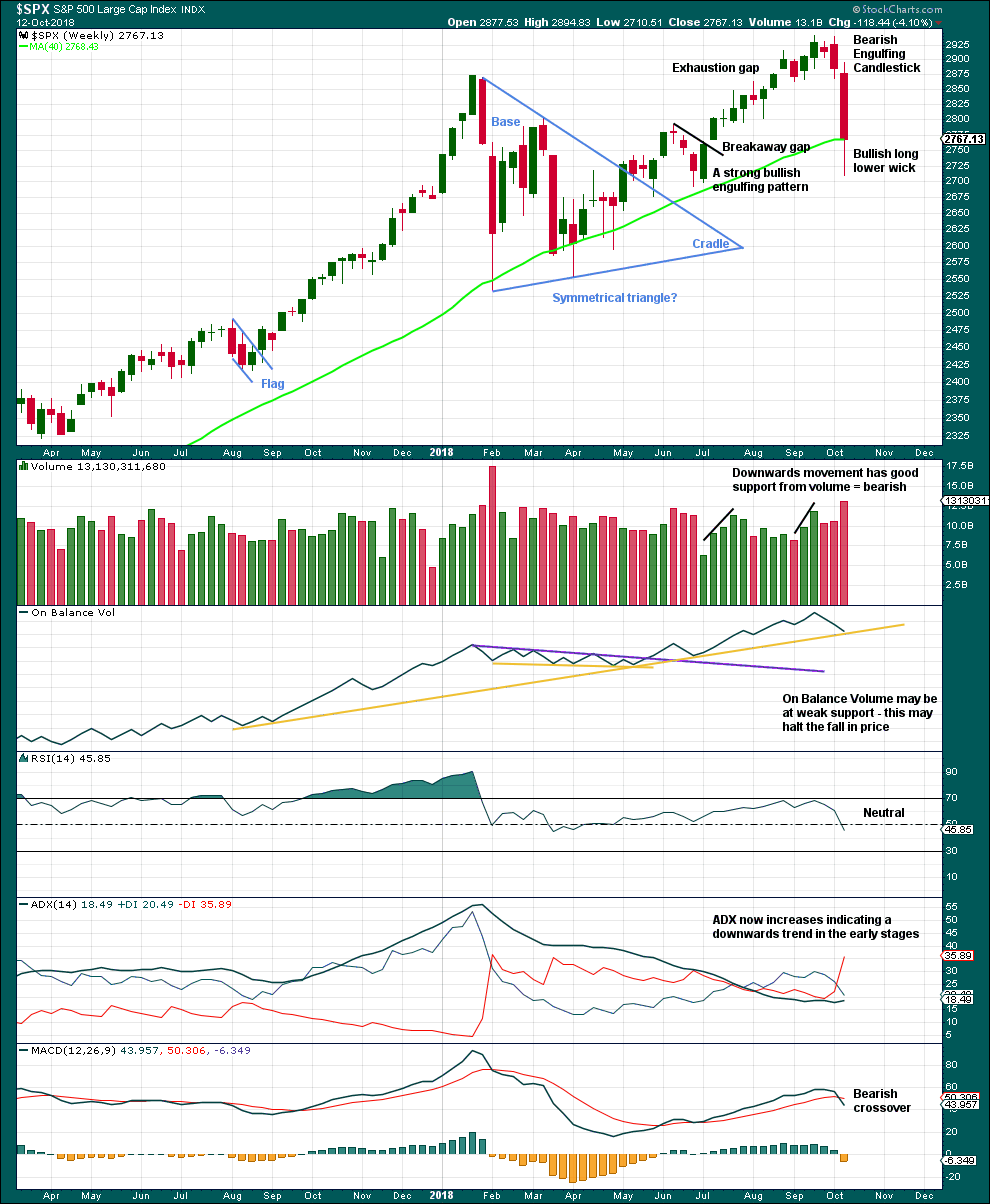
Click chart to enlarge. Chart courtesy of StockCharts.com.
The symmetrical triangle base distance is 340.18. Added to the breakout point of 2,704.54 this gives a target at 3,044.72. This target was not met; it was too optimistic.
The long lower wick on this weekly candlestick suggests a bounce next week.
DAILY CHART
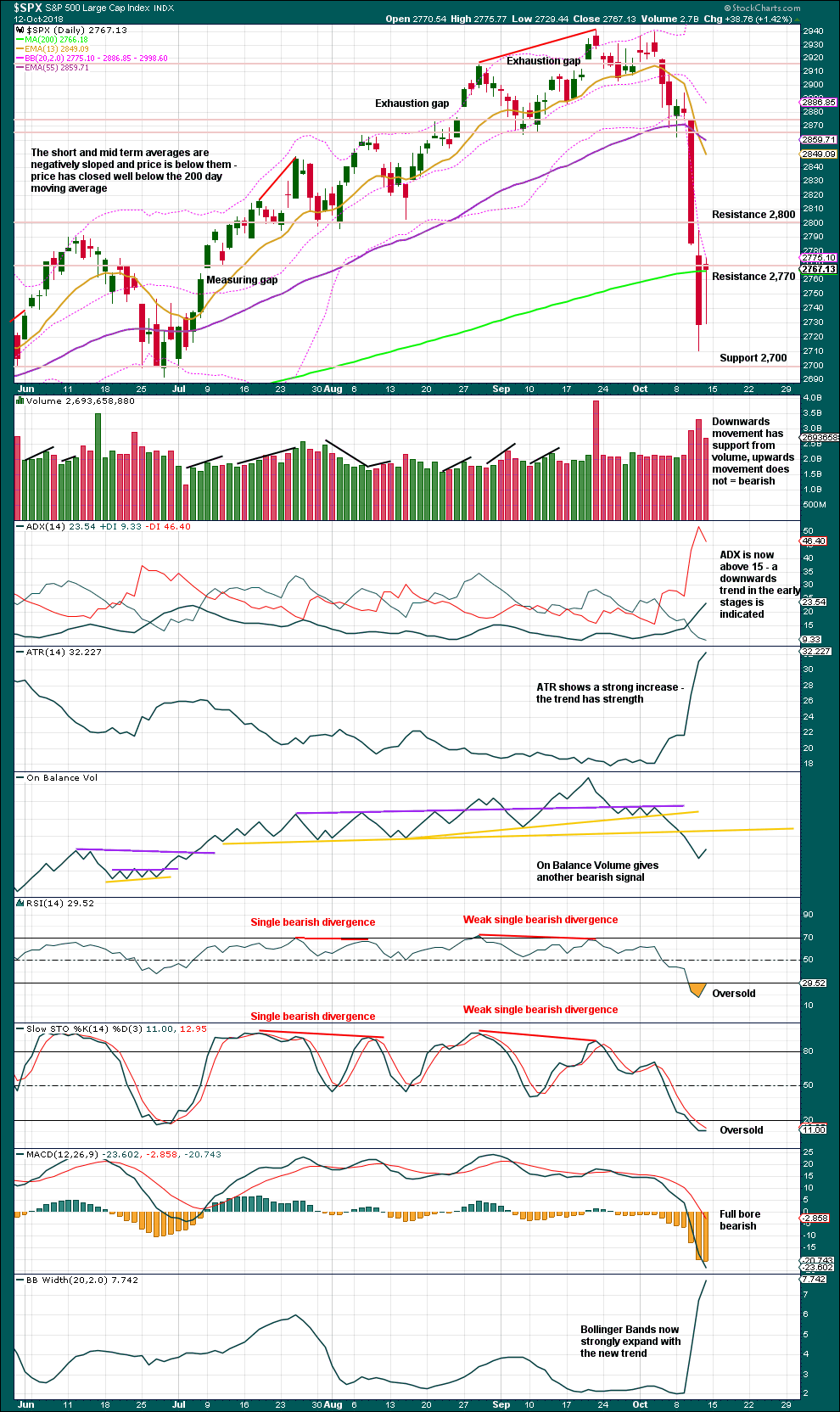
Click chart to enlarge. Chart courtesy of StockCharts.com.
Next support is about 2,700. RSI is now fairly oversold.
There is as yet no bullish divergence between price and either of RSI, Stochastics or On Balance Volume. Nor is there a candlestick reversal pattern. If any of these signals occur, then a bounce may be expected.
For the very short term, the long lower wick on Friday’s candlestick suggests a little more upwards movement to begin next week, but it does not look like a sustained bounce may yet begin. Expect upwards movement to be over within a very few days and be followed by another low to 2,700. Some bullish signals at the next low may develop.
VOLATILITY – INVERTED VIX CHART
WEEKLY CHART

Click chart to enlarge. Chart courtesy of StockCharts.com. So that colour blind members are included, bearish signals
will be noted with blue and bullish signals with yellow.
Primary wave 4 has now arrived and is showing reasonable strength. There is continuing mid term bearish divergence this week with inverted VIX making a new low below the prior swing low of the week beginning 25th June, but price has not yet made a corresponding new low.
As primary wave 4 continues this weekly chart may offer a bullish signal at its end.
DAILY CHART
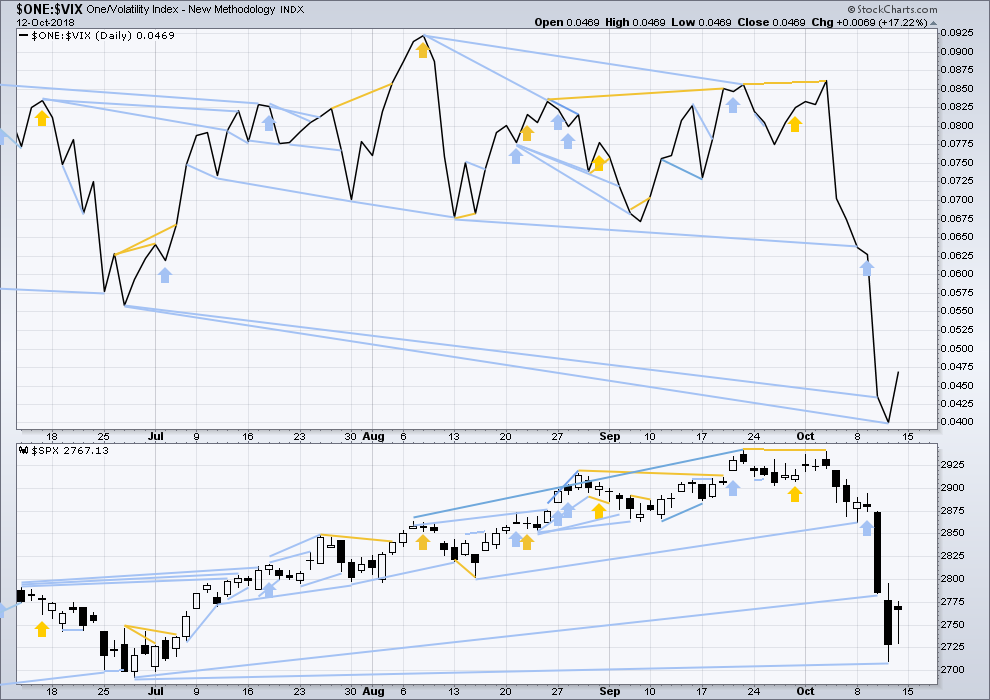
Click chart to enlarge. Chart courtesy of StockCharts.com. So that colour blind members are included, bearish signals
will be noted with blue and bullish signals with yellow.
Normally, volatility should decline as price moves higher and increase as price moves lower. This means that normally inverted VIX should move in the same direction as price.
There is mid term divergence with a new all time high from price not supported by a corresponding new all time high from inverted VIX. This divergence is bearish.
There are now two days in a row of long term bearish divergence between the low for inverted VIX and the prior swing low of the 27th/28th June. Inverted VIX has made new lows, but price has not.
BREADTH – AD LINE
WEEKLY CHART
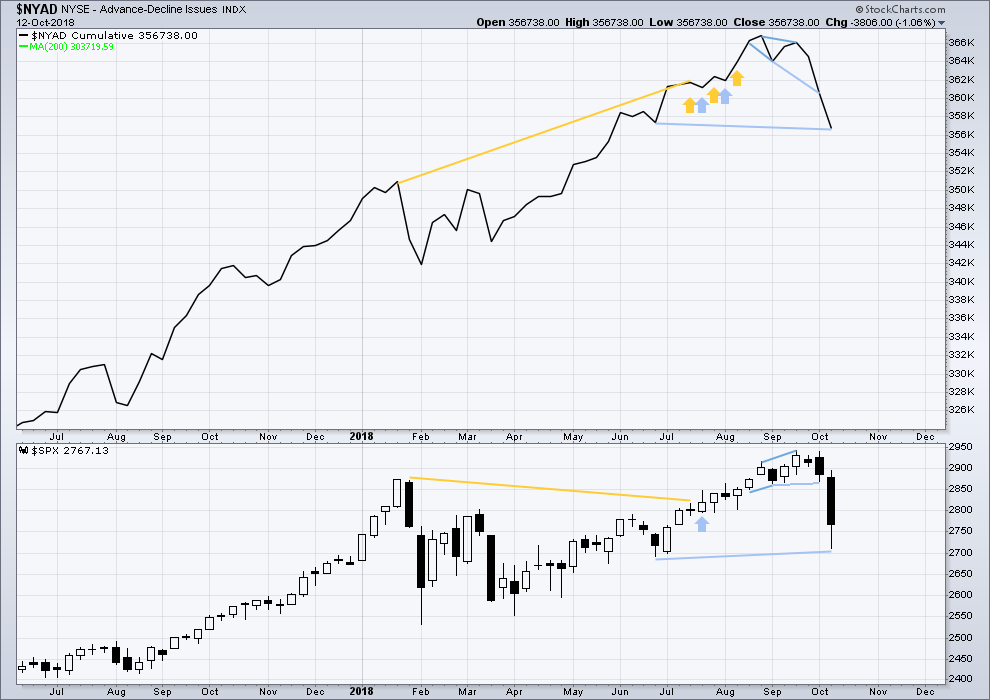
Click chart to enlarge. Chart courtesy of StockCharts.com.
When primary wave 3 comes to an end, it may be valuable to watch the AD line at the weekly time frame as well as the daily.
This week the AD line has made a slight new low below the prior swing low of the week beginning 25th June, but price has not. This mid term divergence is bearish, but it is weak.
DAILY CHART
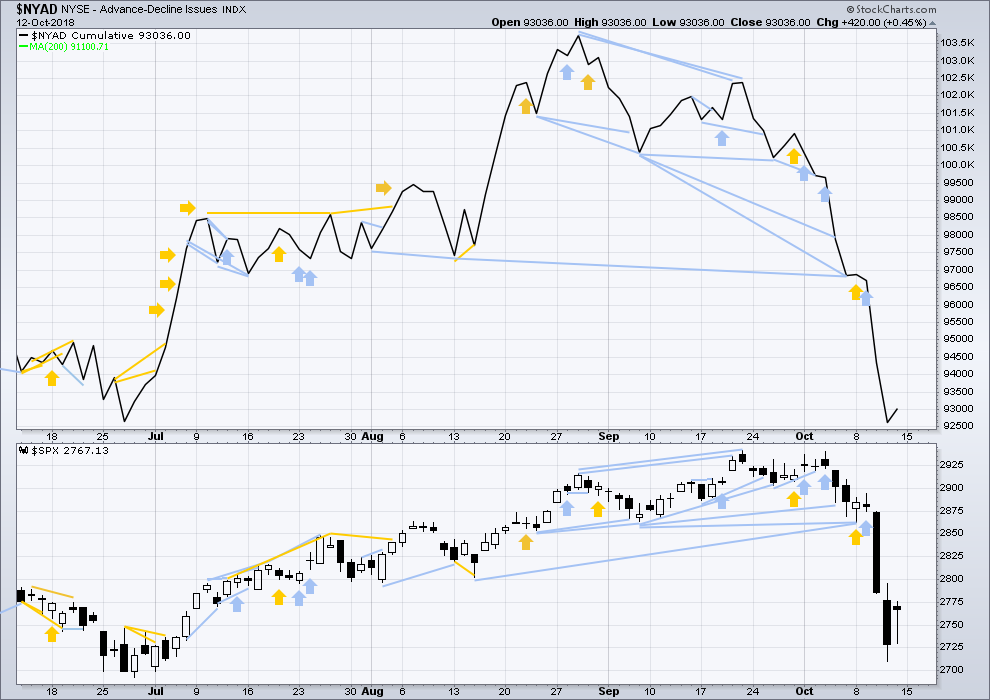
Click chart to enlarge. Chart courtesy of StockCharts.com.
There is normally 4-6 months divergence between price and market breadth prior to a full fledged bear market. This has been so for all major bear markets within the last 90 odd years. With no longer term divergence yet at this point, any decline in price should be expected to be a pullback within an ongoing bull market and not necessarily the start of a bear market. New all time highs from the AD line on the 29th of August means that the beginning of any bear market may be at the end of December 2018, but it may of course be a lot longer than that. My next expectation for the end of this bull market may now be October 2019.
Because there is less than 4 months of bearish divergence between price and the AD line, the current strong fall in price is expected to be only a primary degree correction and not the start of a bear market. The conditions for a full fledged bear market do not yet exist.
Breadth should be read as a leading indicator.
There is no new short term divergence between price and the AD line.
Both mid and small caps for Friday have long lower wicks. This may indicate a small bounce to continue for a very few days.
DOW THEORY
The following lows need to be exceeded for Dow Theory to confirm the end of the bull market and a change to a bear market:
DJIA: 23,344.52.
DJT: 9,806.79.
S&P500: 2,532.69.
Nasdaq: 6,630.67.
ANALYSIS OF INTERMEDIATE WAVE (4)
TECHNICAL ANALYSIS
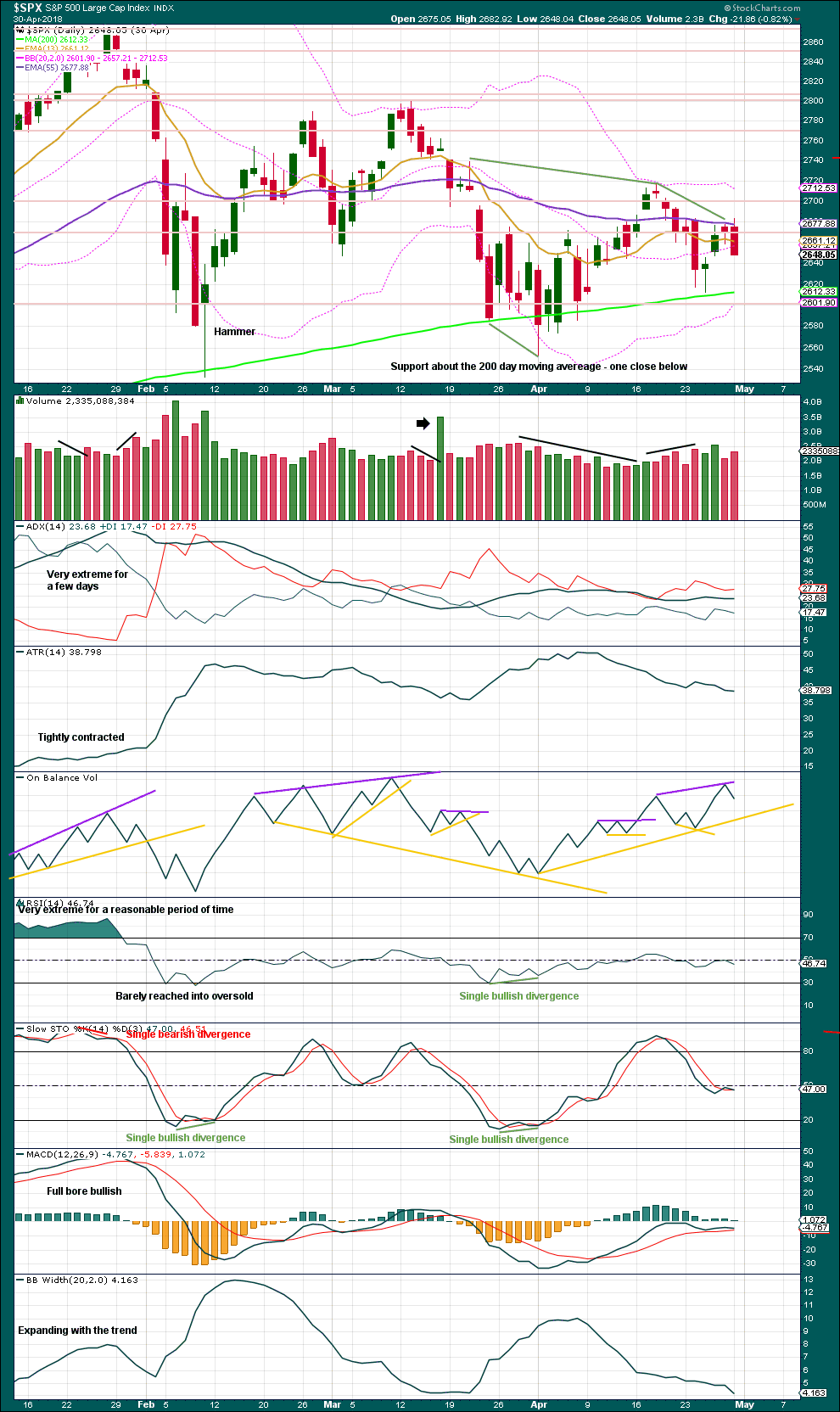
Click chart to enlarge. Chart courtesy of StockCharts.com.
Intermediate wave (4) was a large symmetrical triangle. The deepest wave was the first wave. At its low there was a clear candlestick reversal pattern and bullish divergence between price and Stochastics.
RSI barely managed to reach into oversold.
The current correction for primary wave 4 may behave differently, but there should be some similarities.
It is expected that primary wave 4 may be stronger than intermediate wave (4).
VIX
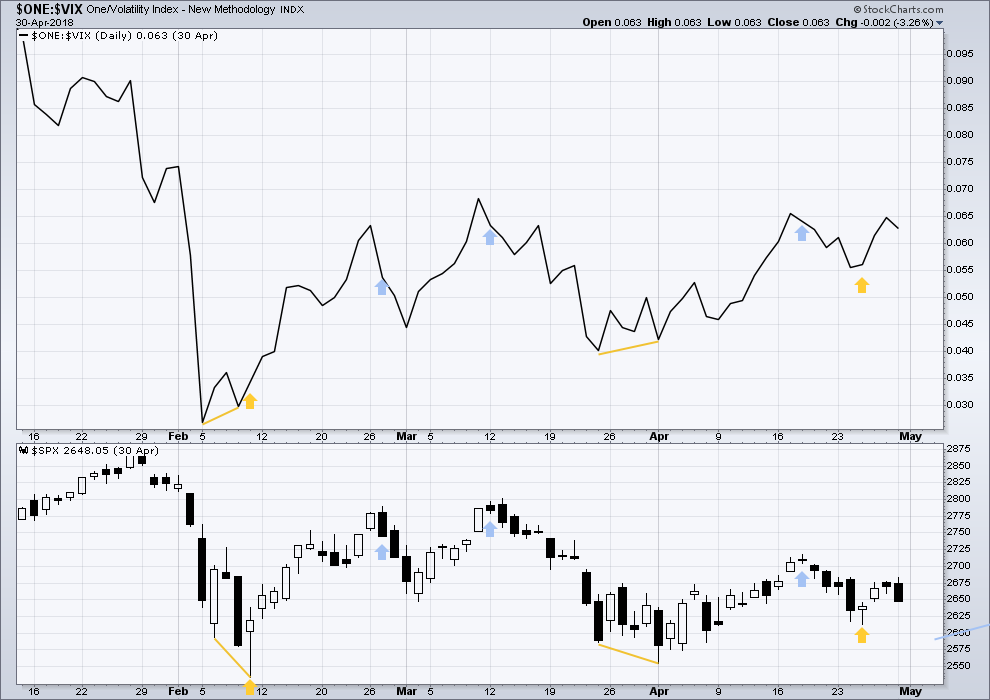
Click chart to enlarge. Chart courtesy of StockCharts.com.
This is a daily chart.
At the two major lows within intermediate wave (4), inverted VIX exhibited single short term bullish divergence.
At highs within intermediate wave (4), inverted VIX exhibited one single day bullish divergence with price.
AD LINE
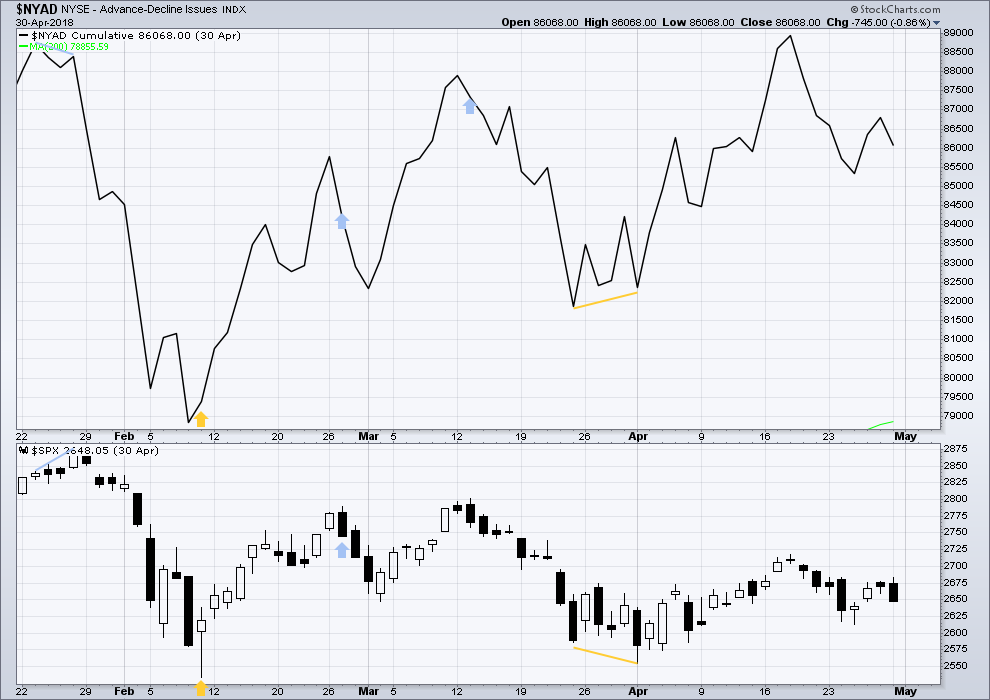
Click chart to enlarge. Chart courtesy of StockCharts.com.
This is a daily chart.
At the two major lows within intermediate wave (4), there was bullish divergence between price and the AD line. At the two major highs within intermediate wave (4), there was each one instance of single day bearish divergence.
Published @ 12:16 a.m. EST on 13th October, 2018.
—
Careful risk management protects your trading account(s).
Follow my two Golden Rules:
1. Always trade with stops.
2. Risk only 1-5% of equity on any one trade.

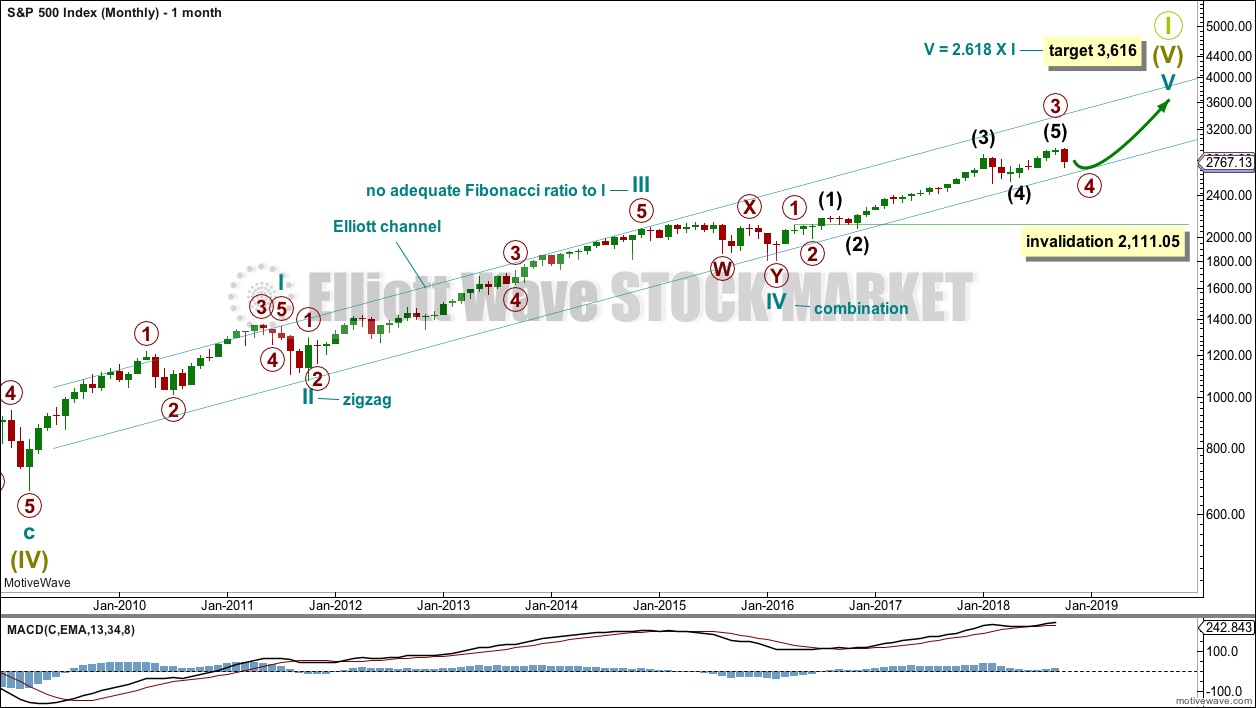
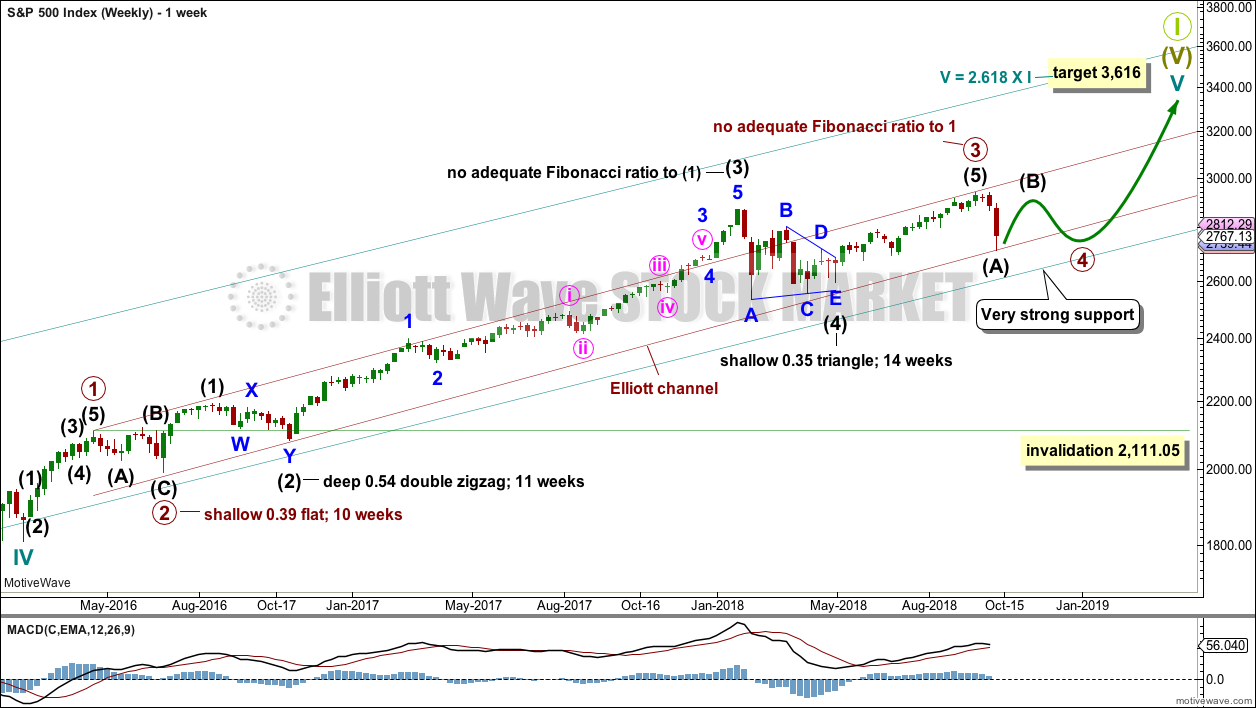

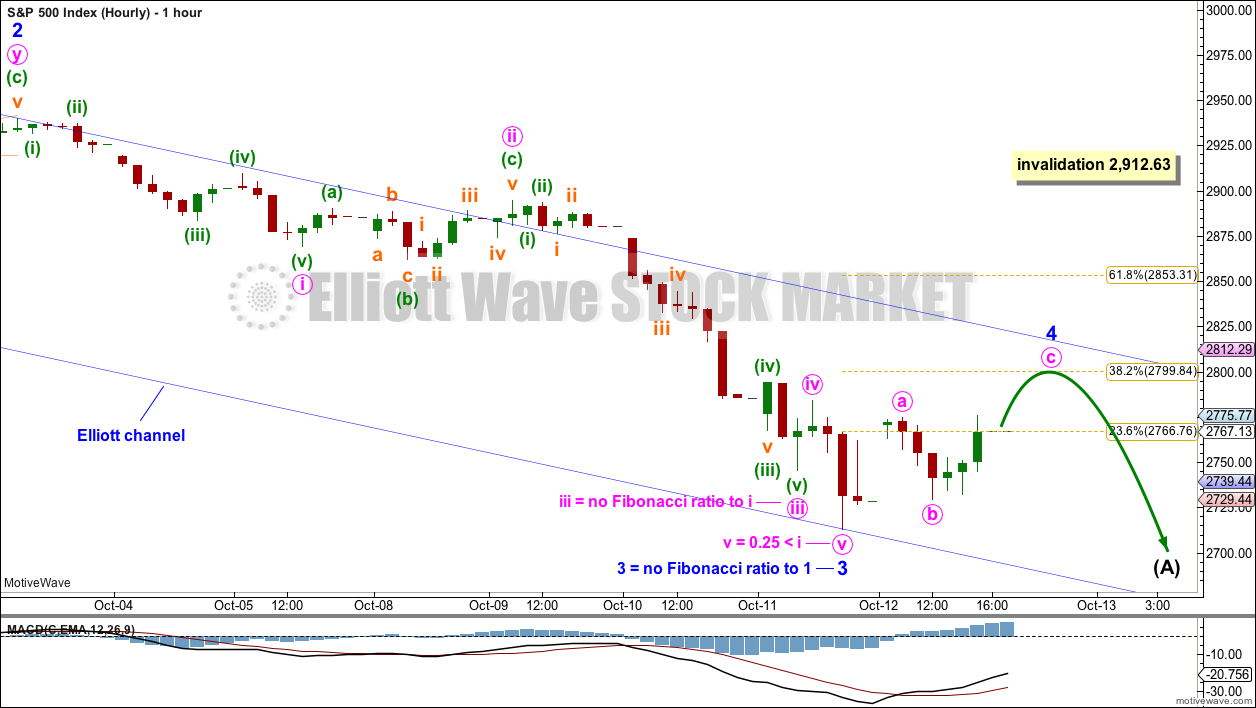
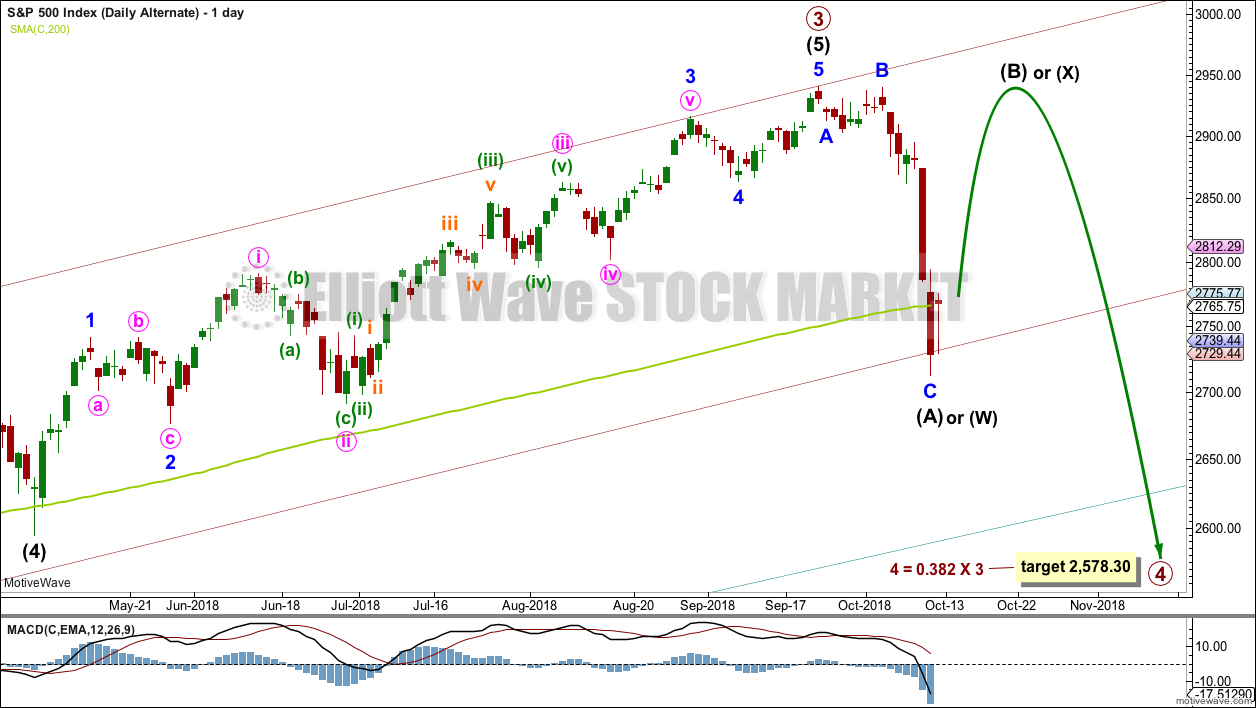
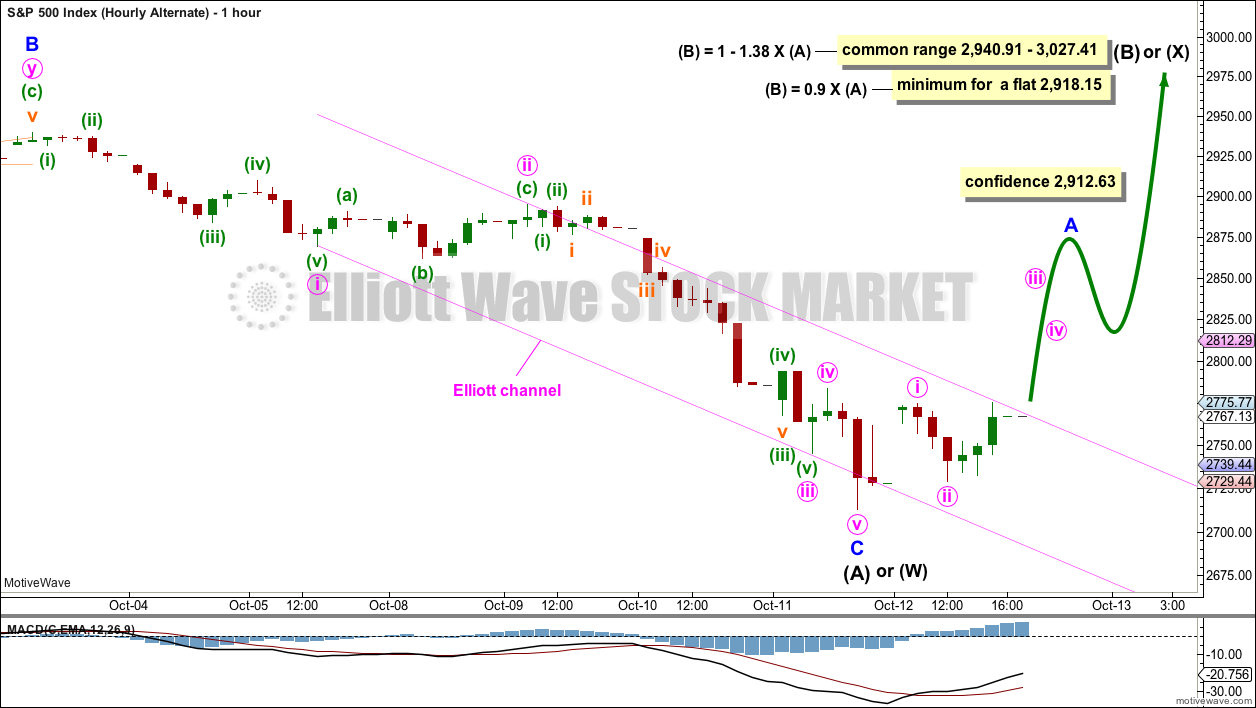
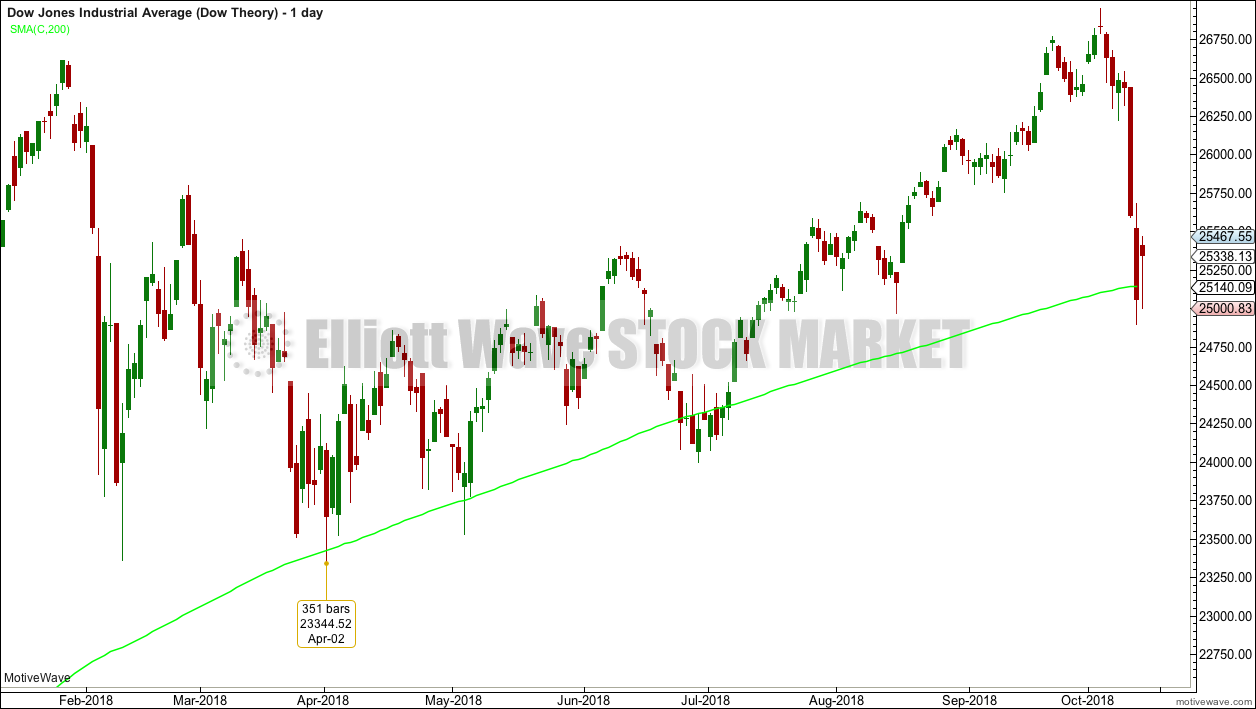
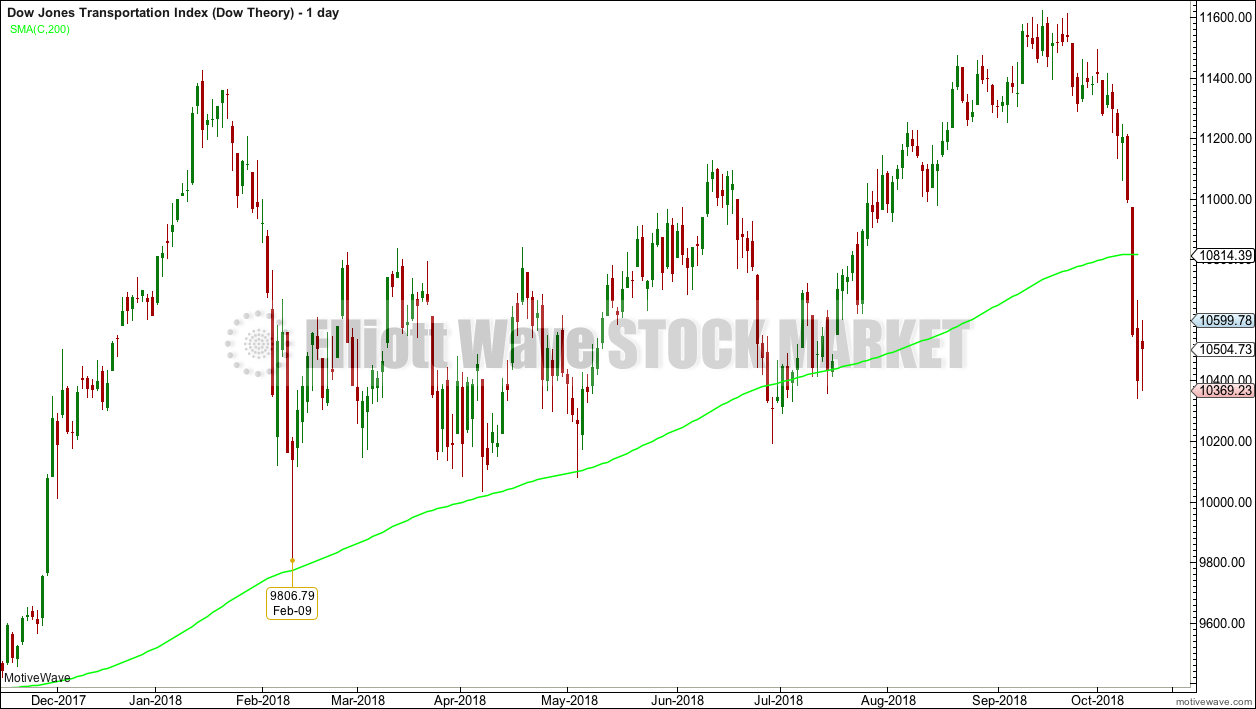
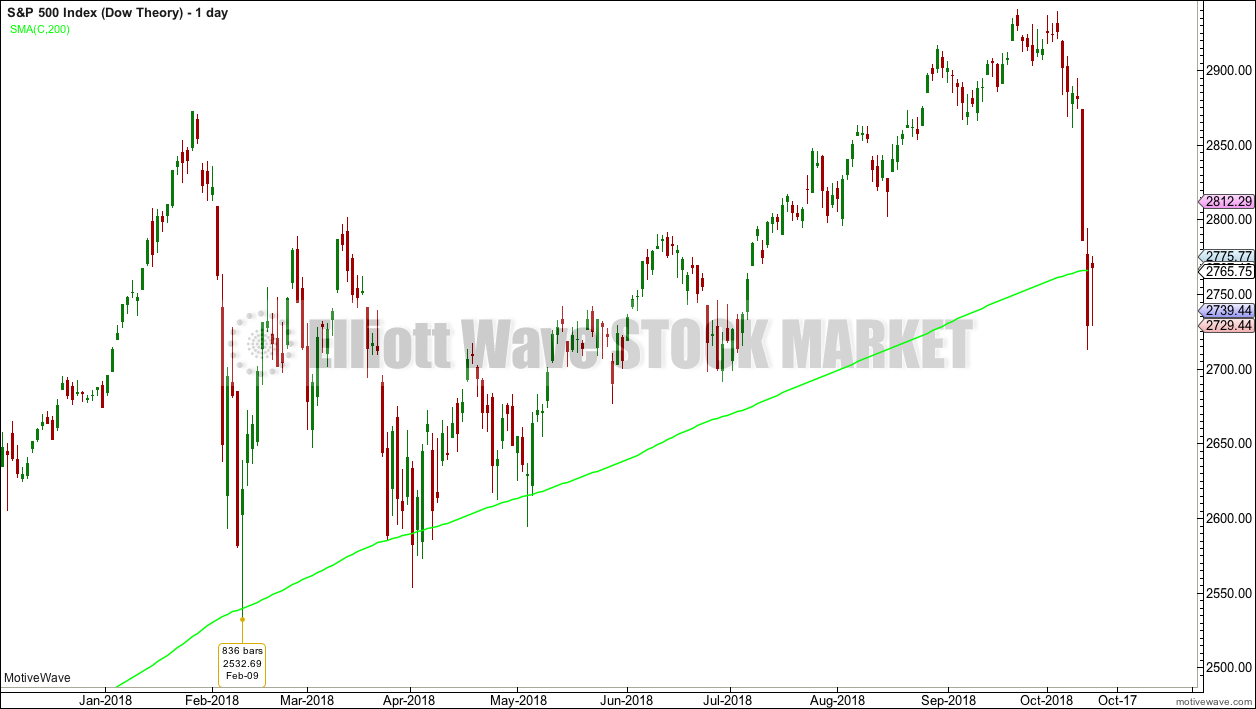
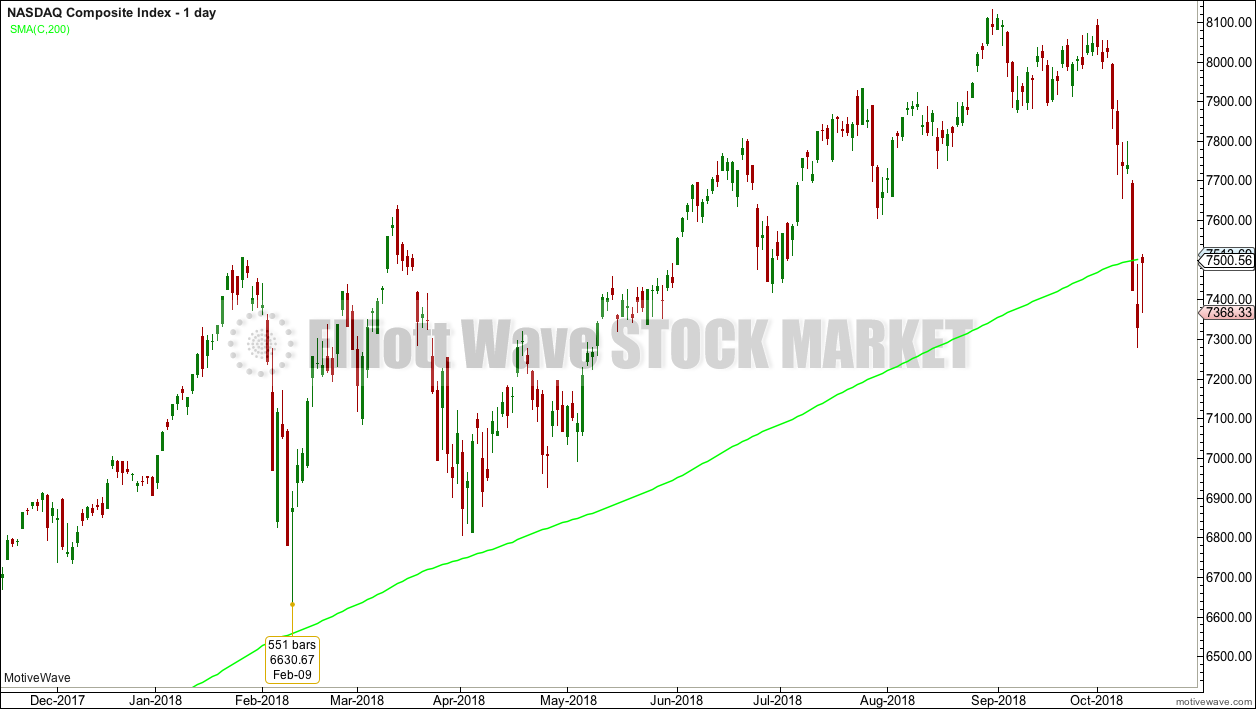
6.7 earthquake off the coast of NZ…. hope all is OK
test
It works! Our next step is to email all members of EWSM to see if anyone here is having problems posting comments.
We received a decent number of replies over at EWG. Cesar now has some information to help him find the problem.
Where’s today’s update?
These triangles seem too easy. It’s free money. Who is on the other side of these trades I wonder and what is their end game?
Until it isn’t.
Sure, but with decent risk management and reasonably sized positions, you can limit downside exposure while racking up gains up until the pattern is broken. These triangles are literally textbook. The consistency has been truly astonishing.
🙂
Hourly chart updated:
It looks like a B wave triangle may have just completed, it’s also possible it could continue a little sideways.
Then I’d be looking for wave C to bring minor 4 up to the 0.382 Fibonacci ratio.
Today looks like a small pause within a downwards trend.
If the triangle for minute b continues further sideways: minuette (d) may not move beyond the end of minuette (b) above 2,775.77. And so a new high reasonably above this point which would give the (b)-(d) trend line a positive slope would mean the triangle must have been over, and so minute c upwards should then be underway.
Hi Lara
Lol it’s breaking out to the downside!
Does that change anything?
Thank You
I see SPX price getting very close to a lot of resistance: prior swing highs (marked by yellow darvas box line), the descending upper trend line, and a 38% retrace fibo.
If it breaks all that, “the bounce is on”. If not, by definition, it’s not.
The resistance is holding. However, now SPX is in it’s second hour of squeeze, with momentum rising into it. A bit more likely to break out of it upward…but no guarantees of that.
SPX 5 minute. Resistance holding strong. Squeeze continuing. “triangle” get scribbled on now. I find such Edwards/McGee structures that fully show themselves only at the 5 minute or less TF to be suspect re: their “traditional” predictive powers at higher tf’s (daily, weekly).
The longer it doesn’t break to the upside, the more chance it’ll end up breaking down, IMO.
Hi Kevin
After-hours to the downside change anything here?
Thank You
Still waiting for the bounce
Classic move up out of triangle to complete C wave. A very reliable and predictable set up. Always returns a quick double with carefully chosen options. Hope you traded it!
Have a great day!
Looks like it is an ABC upwards correction for a fourth wave. The B triangle should resolve with a sharp C wave higher followed by the fifth wave down of the impulse.
Perfectly spotted!
Why thank you Mi’Lady. I have, after all, been some time learning from an expert have I not? 🙂
So far the first two weeks of the P4 have an identical look to the 1st 2 weeks of the I4. Except “slight smaller” in the price dimension. But we expect this P4 overall to be “stronger” (larger in price top to bottom). So…I would guess that mirroring isn’t going to last, and hence the odds of a triangle here are a bit less and a large zig-zag or combo down a bit more likely.
Also, any failure to bounce with some authority quickly this week would strike me as a screaming warning of the next leg down about to start up with it’s own authority.
Lara, if I am reading correctly the summary targets P4 at about 2700 while daily chart and supporting text target P4 about 2578.
Is it possible to determine which target is most probable?
At this stage I would have to judge the target about 2,700 to have a higher probability, simply because the lower target at 2,578 would require a reasonable overshoot of the teal channel.
And so we should expect support at that trend line to be very strong indeed.
It may be that primary wave 4 does not end close to a Fibonacci ratio of primary wave 3, and it is true that pullbacks do not always end close to Fibonacci ratios.
Thanks.
Hi Lara
You mention 2700. Any idea on a time frame
Hi Lara,
I just read some information about chart gaps. Now I’m paying much more attention to them. I noticed that on your alternate hourly chart on October 12th there was a huge gap at the open. Would it be correct to interpreted it as a breakaway gap? Which leads me to the next question, if we gap up again on Monday could that be considered an acceleration gap? If so, would that strongly support the alternate wave count? My final question is would a large breakaway gap provide much downside support if any for the overall correction since there was not a lengthy consolidation period? I’m trying to learn how these gaps can be helpful in making trading decisions. As always thank you!
The gap on the hourly chart from the open on Friday looks much more like a pattern gap and these are usually closed.
Breakaway gaps have to break away from something. So they come after some kind of consolidation with identifiable support and resistance.
Friday’s sideways chop now looks like a consolidation with resistance about 2,775 and support about 2,730. If Monday opens with a gap which breaks above resistance or below support then that would be a breakaway gap and may then be used in trading to offer support or resistance, because breakaway gaps should not be closed.
If price gaps up from Friday’s consolidation then yes, expect a breakaway gap there to provide support while the resulting trend continues. But remember, this is at the hourly chart level so the resulting trend may be only lasting days.
I have some useful articles in the “education” category over at Elliott Wave Gold. To access these articles you will need to be viewing a public analysis (unless you’re a member then any post will do). Once in a post go to the RH sidebar and find the “categories” drop down box. Choose “education”. Have a scroll through, there’s about three pages.
Regarding gaps I have three articles; here, here and here.
Kirkpatrick and Dhalquist “Technical Analysis” has a good chapter on gaps too. I highly recommend this book for good coverage of technical analysis.
What a crazy market…but fun!
I do not ever recall seeing DJIA make multiple DAILY 300+ point round trips. Yikes! Talk about volatility. The price action on Friday looks to me like some kind of triangle, one of my personal faves ( have I mentioned that before? lol!). If that is the case, we tag the upper boundary to complete an E wave and then we slice through the lower boundary like a hot knife…well…you know!
Happy Trading! 🙂
Numero Uno.
No yer not, Doc.
My friend Bruno here is…!